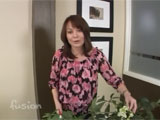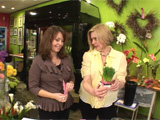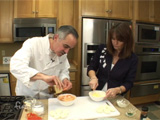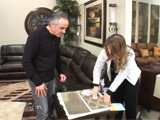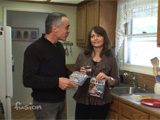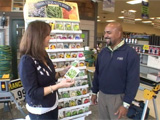EPISODE #30-
SATURDAY APRIL 3, 2010
The spring
breaks are wrapping up and everyone is
returning to a normal schedule again. Still,
my thoughts keep turning back to projects
around the home and in the garden. Before I
tackle some of those chores I will take a
little time to celebrate Easter, and to help
celebrate, we show you a couple of recipes
for eggs. And with all the relatives over
for the celebration, don’t worry about a few
stains. We have some tips for removing those
stains from your upholstery!
Floating
Flowers
Setting
Your Easter Table
The Perfect
Hard Boiled Egg
Deviled
Eggs
Furniture
Cleaning
Toxins in the Home
Parr Gardening
Also, stop by and meet Robin and David
today, Saturday, April 3rd between
8:00am-4:00pm at Fir Point Farms in Aurora.
Check out
www.Gardenpalooza.com for details,
directions, coupons and more. It is a FREE
event with FREE parking. We will see you
there!![]()
If you have a late winter or
early spring garden you probably have
hellebores growing in it. You can enjoy
those beautiful blooms without going outside
with this little tip. Just cut off the bloom
and bring it indoors. Float the flower face
up in the small bowl of water or a wide
glass vase. The water will keep the flower
from drying out and you can enjoy the color
for a couple of weeks!
The spring is a time of renewal. So maybe it
is time to ‘renew’ your table for Easter or
even to make a splash for spring
entertaining. Kim from
Geranium Lake Flowers
(503-228-1920)
walked Robin through a bunch of ideas for
freshening up your look for the season.
Starting with a basic white tablecloth Kim
used a nice set of soft green plates and
included a rose colored napkin underneath.
She made a little vase out of egg shells
that were filled with water and held a
flower, and placed that as each place
setting on the table. For a place card
holder Kim used wheatgrass that she found
growing in trays at a local grocery store.
These were cut into squares that were used
to hold those place cards. She also used the
remaining wheatgrass to build a center piece
that she stuck flowers in to make a very
nice ‘spring’ themed basket/centerpiece.![]()
If you like hard
boiled eggs you know that getting them to
peel perfectly is hard to do. Chef David
showed us a method for creating the perfect
hard boiled egg. First he showed us how you
can tell the difference between hard boiled
egg and a raw egg with out cracking them
open. You spin them! The one that spins
faster and freely is hard boiled. The one
that spins slower and wobbles is the raw
egg. Pretty cool! Now to the boiling… First
you get your pan of water close to a boil
then you add a tablespoon of vinegar and a
half teaspoon of salt and then the eggs. The
reason you don’t want boiling water is
because it will bounce the eggs around and
they could crack and break. Now without
boiling the water, allow them to stay in the
water for 15 minutes. Take them off the
stove and let them cool under running water
for about 4 minutes and peel. If you want a
little more detailed recipe
check
it out here.
We just showed you how to make the prefect
boiled egg. Now we will show you a couple of
ways to make the perfect deviled egg. We
were at the NW Natural Appliance Center to
tackle a couple of tasty variations of this
classic recipe. For most people is it just
mayo and mustard mixed with their egg yolks
to make the filling, but Chef David had 2
very different recipes for 2 great tastes.
Robin did the recipe that included truffle
oil, cayenne and mayonnaise. David’s recipe
included mayo, red pepper, and sherry
vinegar. Robin finished hers with a garnish
of chives and David finished his with smoked
paprika. For the complete recipe click here. Spring
break means spring cleaning for some. There
is nothing like the nice weather to get you
motivated for the summer months ahead. Maybe
it’s the warmth of the sun, or maybe it is
the sun shining through those dirty windows!
Either way we will be sharing tips with you
during the next few weeks to help you get
organized for the warm weather to come.
Find the
recipes here.![]()
The one place where you spend a lot of time
relaxing in your home could be your couch or
recliner. It is also the one piece that is
the first to get stained. Now, how do you
tackle those stains? Monique from
Bassett Furniture (503-469-8333) joined
us to give us some tips for getting those
stains out and saving your furniture. First
she covered leather care. There are 2
different kinds of leathers used in
furniture. If one has a shine or gloss to
it, it is treated and is somewhat protected.
If you spill something on it you can wipe if
off without too much damage. If it has a
dull look it is an untreated leather and if
you spill something on it, it may cause a
stain. The benefit to this leather is that
those little stains and oils will help
create a patina to the leather over time. A
very nice look for some leathers. You should
also clean and condition your leather twice
a year.
If you have a fabric cover to your furniture
you should check for a cleaning code for
your furniture. If you can’t find it on your
tags, you should check the cleaning
instructions you received with your
furniture when you bought it. The first code
we saw was a ‘W’. This means you can clean
that fabric with water without damaging it.
The second code we saw was an ‘S’. This
means that you need to use a solvent when
cleaning. You may also run into a ‘dry
clean’ only fabric under the S symbol. You
will also see a ‘W-S’ symbol this one can
use either a water based, or solvent based
cleaner. The final code is an ‘X’. this is a
vacuum or brush only type of fabric. This
type of fabric can suffer real damage if
treated with water or solvents. No matter
which type of cleaning method you can always
pretest on a small hidden area before
proceeding. The one thing that Monique
recommends is to treat your fabric when you
buy. This will protect your furniture and
make the cleaning much easier. She
demonstrated this by showing us 2 types of
fabric that had been treated and not
treated. After a spill, using a clean white
damp cloth you want to blot the stain and
remove as much as you can before moving to
another cleaner. Blot, don’t rub. Rubbing
will cause your fiber to break down and wear
out faster. If you can use a fabric cleaner,
have it handy. The quicker you can work to
remove the stain the better your results
will be. If you have any questions about
furniture cleaning or fabric choices, stop
by the Bassett Furniture store in Beaverton.
Your home could be getting you sick. There
are lots of different ways that you can be
exposed to toxins in your home. You don’t
need to worry; there are ways you can test
to see if you have any potential dangers. We
found a series of tests at the local
hardware store that can help you assess your
home for problems. One of the most common
problems is mold. You can usually see this
one around your windowsills or on your
walls. If you have mold it can cause
respiratory problems and rashes. We found a
test that will allow you to find mold
whether you see it or not. You can either
place the test in your home and once the
mold cultures are grown you can send it in
for testing. Or if you find some mold you
can take a sample and send it in. The
results will tell you if you have a
‘problem’ mold and whether you should clean
it or not. Another common problem in the
home is radon gas. Radon is a naturally
occurring gas that is formed by the
break-down of Radium in your soil. This gas
can seep into your home and cause lung
problems. In fact, radon gas is the second
leading cause of lung cancer after smoking.
This test involves leaving the test
canisters out in your home for a period of
time and then seal them up and send them in
for testing. The next stop on our testing
tour is the kitchen. Here we talked about a
test for lead in your drinking water. Most
cities have continuous testing for lead in
their water systems, but you still can get
lead in your water from lead solder in pipes
leaching in to your water. You may also have
lead if you have a well and your water is
compromised. There are also other tests for
water that will tell you what different
types of minerals and other dissolved solids
you have in your water. You can also buy
little ‘lead indicator sticks’. These sticks
can just be wiped over a surface and if
there is lead, it will change color. This is
good to use on cooking utensils, paint on
walls, plates, silverware and toys. Some of
these tests require a lab fee for processing
and some you can get the results right away.
Check the packages for details.
If you are tired of taking care of stuff on
the inside, you can take a break outside. We
stopped by Parr Lumber to find that they
have ways for you to beautify your garden
too. Chris Erskine showed us the great
selection of seeds that Parr now carries.
You can start with the seed, but they also
carry planters, potting soil and watering
tools. They even have a kit called ‘Drip
Irrigation for Dummies’ which makes anyone
an expert. Parr even has all the other tools
you will need including rakes and shovels!

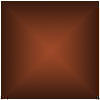


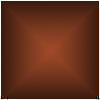
Website design and content ©2009 Gustin Creative Group. Please
send website inquiries to
gustingroup@comcast.net.
This page last modified
August 13, 2010.










